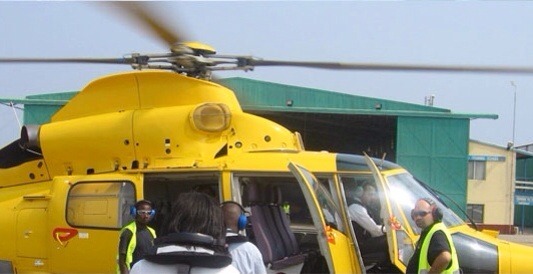THE REAL HELICOPTER–AND NO WATER LANDING: (Part Two)
As we approached the helicopter for boarding, the propeller(s) had already started up. It’s made very clear that one must never approach from the front or the back of the helicopter, or carrying a tall object vertically. They don’t call them “choppers” for nothing.

APPROACHING THE CHOPPER (Photo courtesy of Tullow Oil)
The noise level is high, so ear protection acoustic headphones should be on already at the time of boarding. Sharp-eyed attendants are on hand to chaperone you toward the craft and prevent you from straying from the path, just in case you suddenly have a bright idea you’d like to head toward the nose or tail of the helicopter. Attendants also help strap you into your seat in the four-point belts that I was now familiar with from my training. This particular NHV Helicopter seats eight in two rows of four abreast, one in front, and one behind. On the outgoing journey I was in the back row, and on the return, I was in the front. It made quite a difference, which I’ll explain later.
There are usually two pilots in the cockpit, in our case the captain–the graying, obviously more senior one, and a younger copilot, both white males. The captain made a routine welcome announcement, similar to that made on a commercial airliner, which came out thin and scratchy in our earmuffs. The two pilots made double checks on all the controls, flicking a bewildering array of switches and levers and communicating with each other via their headphones.
Then, with a thumbs-up to the ground marshall (the person who gives those fancy hand signals to the pilot), we were ready to go. Like Darko, I was barely aware that the chopper had lifted off the ground, so gentle and imperceptible was the motion. I only fully realized we were up when we magically swiveled to the right and moved toward the runway, where we turned left and hovered again. Accustomed to the forward-ever-backward-never motion of an airplane, the sensation of being stationary in mid-air as if suspended by invisible cables attached to the roof of the sky is really spectacular. And then with a slight genuflecting dip of the helicopter’s nose, we moved forward smoothly as if gliding along a slick, lubricated rail.
I was at the right-side window, so I had a terrific view of Takoradi the city as we rose in the air. As Darko noticed, it’s a patchwork of buildings and still a lot of green space–much more than Accra. It seems I missed a good view of the harbor, which I might have seen if I had been sitting on the port (left) side. I had thought we would immediately head out to sea almost perpendicular to shore, but in fact we followed the coast closely for about 15 minutes before switching direction. I’m glad that’s the way it was done, because I was able to view the three peninsulas that give Cape Three Points its name. Even more fascinating, I saw the southernmost tip of Ghana, a diamond-shaped piece of land surrounded on all sides by fluffy white surf. This is the land mass closest to zero longitude (the Greenwich Meridian), zero latitude (the Equator), and zero sea level–or the “land nearest nowhere.) I would have loved to have photographed this, but picture-taking was disallowed without prior permission of the captain, which I had not arranged.
Higher up, above the clouds, visibility was reduced and the view of the Atlantic Ocean was hazy, nothing like that described in Murder at Cape Three Points, although I did spot a few trawlers or possibly supply vessels going to or coming from the rig. Fraser also pointed out to me the floating, production, storage and offloading (FPSO) tanker called the Kwame Nkrumah, after Ghana’s first president and pan-Africanist.
Within some 45 minutes or so, the oil rig came into view, and we rotated about 90 degrees to make the approach to the helipad, marked appropriately with a big “H” which I assume might be useful in stormy conditions where visibility is impaired. Not in this case however. Unlike the tumultuous North Sea, the Gulf of Guinea is calm and well-behaved. As we approached, the helipad transformed from its toylike appearance when viewed from afar to the huge platform it is in reality, and once again we were hovering in mid-air, this time over the “H.” Then, with the delicacy of a lady, it touched down.
Next: touring the West Leo rig, which in Murder at Cape Three Points is described as a creature “afloat on powerful, squat limbs, it’s gangly crane booms resembl[ing] tentacles.”



